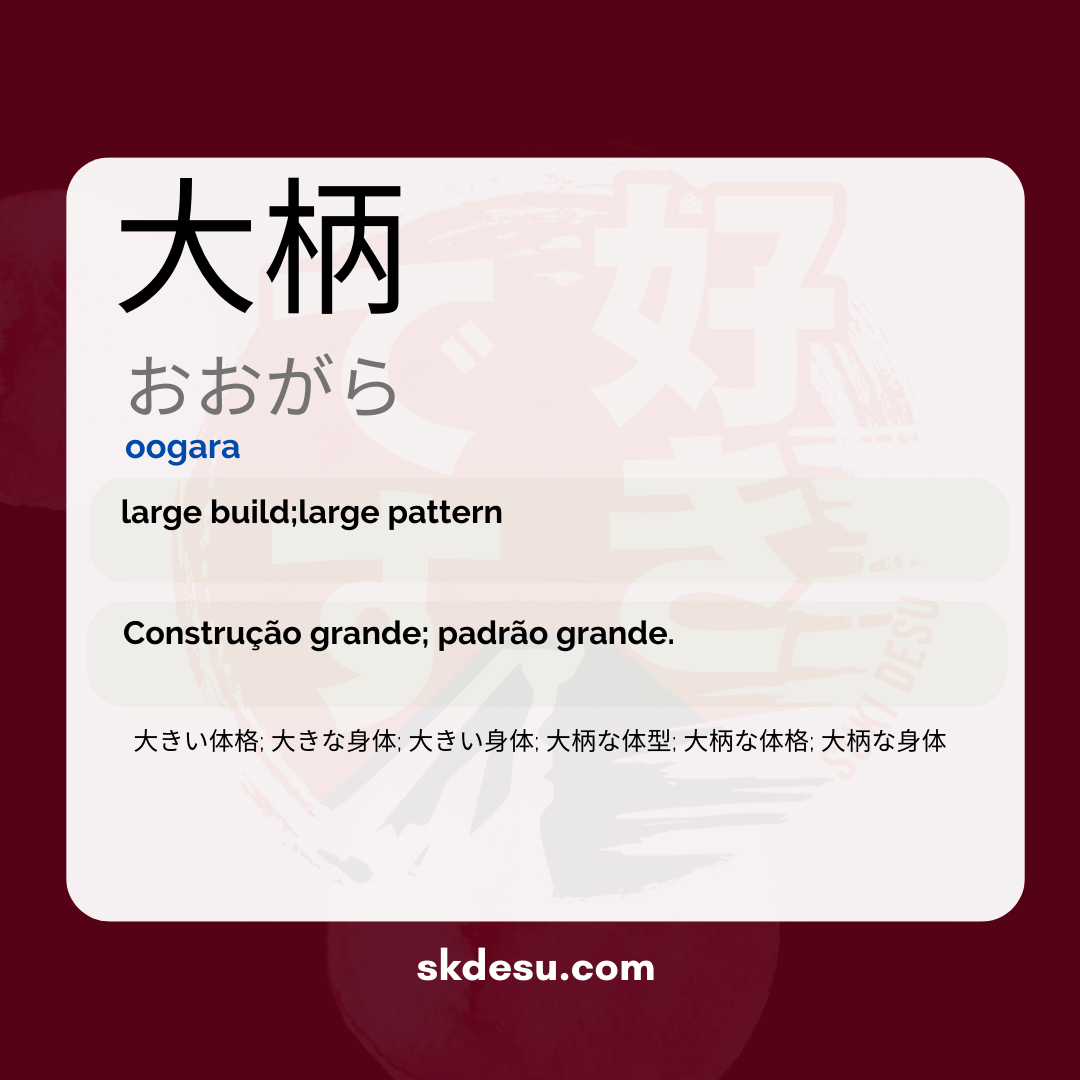Translation and Meaning of: 大柄 - oogara
The Japanese word 大柄 [おおがら] is a term that sparks curiosity both for its kanji writing and its meaning. If you are studying Japanese or simply interested in Japanese culture, understanding what this expression represents can be quite useful. In this article, we will explore everything from the meaning and origin to the everyday use of this word, as well as tips for memorizing it easily.
Whether for those seeking accurate translations or for those who want to learn more about the Japanese language, Suki Nihongo offers the best explanations about terms like 大柄. Here, you will discover how this word is used in different contexts and why it is relevant in the Japanese vocabulary.
Meaning and usage of 大柄
The word 大柄[おおがら] is composed of the kanjis 大 (big) and 柄 (pattern, style, or print). Together, they form a term that can be translated as "large pattern" or "large size." However, its meaning goes beyond the literal, and it can apply to both objects and people.
When used to describe a person, 大柄 generally refers to someone tall or with a robust physique. In relation to clothes or fabrics, it indicates a large pattern or wide prints. It is interesting to note that, although the term may have a neutral connotation, in some contexts it can carry a more descriptive tone rather than necessarily being positive or negative.
Origin and etymology of 大柄
The origin of 大柄 is directly linked to the combination of the kanjis that compose it. The character 大 is one of the most basic in the Japanese language, meaning "big" or "immense." 柄 has a broader meaning, which can refer to patterns, designs, or even the "style" of something or someone.
This combination is not exclusive to Japanese, as kanji have roots in classical Chinese. However, the specific use of 大柄 as an adjective to describe large size or patterns is a natural evolution within the Japanese language. It is worth noting that, although it is a common word, it is not among the most frequently used in daily life, appearing more in descriptive or specific contexts.
How to memorize 大柄 and use it correctly
One of the best ways to memorize 大柄 is to associate its kanji with the meaning. Since 大 represents "big" and 柄 is related to "pattern" or "style," it's easier to remember that the word refers to something of a wide size or print. A tip is to think of a piece of clothing with large prints – this helps to solidify the term.
To use 大柄 correctly, it's important to pay attention to the context. If you are describing a tall person, for example, you can say "彼は大柄だ" (Kare wa oogara da). For fabrics, sentences like "この生地は大柄の模様がある" (Kono kinu wa oogara no moyou ga aru) are appropriate. Practicing with real examples is the key to mastering the use of this word.
Vocabulary
Expand your vocabulary with related words:
Synonyms and similar words
- 大きい体格 (Ōkii taikaku) - Large body with an emphasis on structure
- 大きな身体 (Ōkina karada) - Large body in a broader sense
- 大きい身体 (Ōkii karada) - Large body with a more subjective focus
- 大柄な体型 (Ogarana taikei) - Large body type with a focus on shape
- 大柄な体格 (Ogarana taikaku) - Large body structure with a more formal connotation.
- 大柄な身体 (Ogarana karada) - Large body with a focus on physical nature
Related words
Romaji: oogara
Kana: おおがら
Type: Adjective, noun
L: jlpt-n1
Translation / Meaning: Large construction; large standard.
Meaning in English: large build;large pattern
Definition: To have a big body.
Quick Access
- Vocabulary
- Writing
- Sentences
How to Write in Japanese - (大柄) oogara
See below a step-by-step guide on how to write the word by hand in Japanese. (大柄) oogara:
Example Sentences - (大柄) oogara
See below some example sentences:
Otokonoko ga michi wo aruite iru
A big man is walking down the street.
A big man is walking on the road.
- 大柄な - large
- 男性 - man
- が - subject particle
- 道 - path/street
- を - direct object particle
- 歩いている - walking (continuous form of the verb 歩く)
Other Words of this Type: Adjective, noun
See other words from our dictionary that are also: Adjective, noun

